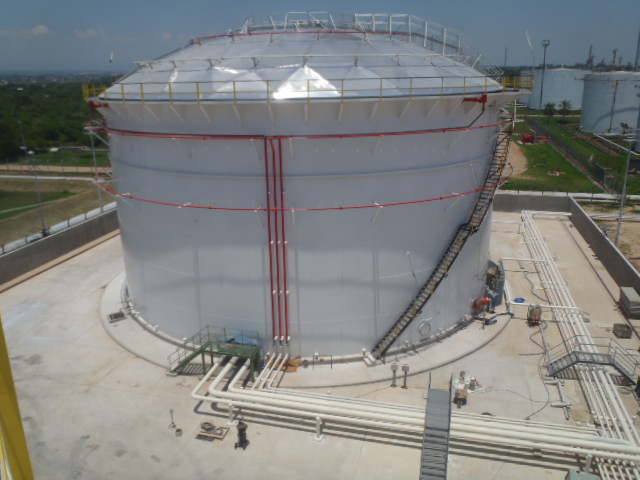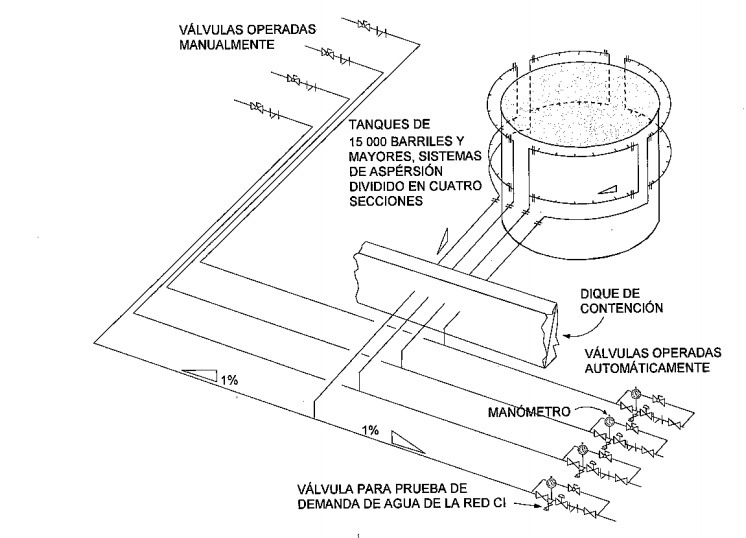Storage Safety: Tank Cooling According to NFPA and API Standards
Ing. José Félix Acevedo B.
3/22/20253 min read


Introduction
The use of water as a cooling medium in storage tanks for hydrocarbons and flammable chemicals is a key strategy for fire mitigation and thermal control in industrial facilities. This article explores best practices for cooling storage tanks, including fixed-roof, floating, horizontal, vertical, and sphere tanks, in accordance with NFPA 15, API 2001, API 2030, and API 2021 standards. In addition, some oil companies, such as PDVSA and Pemex, have internal regulations that establish particular criteria in the design and operation of these systems.
Importance of Storage Tank Cooling
Water cooling systems serve several critical functions:
Overheating prevention: Reduces the temperature of the tank surface to prevent spontaneous ignitions.
Structural Protection: Prevents loss of mechanical integrity of the tank due to prolonged exposure to high temperatures.
Reduction of the effect of thermal radiation: Decreases the transmission of heat between tanks in fire events.
Fire Control: Supports fire suppression strategies through indirect cooling and flammable vapor reduction.
Applicable Standards
NFPA 15 - Water Sprinkler Systems
NFPA 15 sets out requirements for water cooling systems in industrial facilities, including:
Design and installation of sprinkler systems for fire protection.
Methods of applying water to storage tanks.
Minimum flow rates and coverage of cooling systems.
API 2001 - Fire Protection in Hydrocarbon Storage and Handling Facilities
Define strategies for fire mitigation in storage tanks.
Establishes the need for cooling with water as a preventive and control measure.
Recommends the use of sprinkler systems and water monitors for the protection of tanks exposed to thermal radiation.
API 2030 - Guide for Risk Assessment in Hydrocarbon Storage Facilities
Includes the analysis of fire scenarios and the need for cooling.
Provides criteria for determining the amount of water needed to prevent the spread of fire.
API 2021 - Guidelines for the Protection of Spherical Tanks and Horizontal and Vertical Vessels
Specifies the application of cooling systems in liquefied gas storage spheres and horizontal and vertical vessels.
Indicates the criteria for water distribution to avoid structural failure due to exposure to extreme heat.
Internal Standards of Oil Companies
Oil companies such as PDVSA, Pemex and other international operators establish specific criteria in their internal regulations for cooling systems. These criteria may include:
Additional parameters of water pressure and flow.
Design of specific sprinkler systems for each type of tank.
Activation strategies and emergency response times.
Inspection and maintenance procedures that are stricter than those established in international standards.
Cooling Water Application Methods
Water cooling systems can be implemented in a variety of ways, depending on the type of tank:
Fixed Roof Tanks
Application using perimeter sprinklers and water monitors.
In vertical fuel tanks on fire, the tank shell must be cooled to prevent it from collapsing, but being very careful not to inject water into the tank, as this could cause the generation of boilover.
Recommended flow rate of 8.1 L/min/m² (0.2 gpm/ft²) of exposed surface.
Continuous cooling in the event of fire in adjacent tanks with a recommended flow rate of 4.1 L/min/m² (0.1 gpm/ft²).
In tank farms, sprinkler piping systems may be sectioned or divided so that a sprinkler pipe branch is available for each quadrant of the tank. This is intended to optimize water use and cool the tank quadrants that are effectively under thermal radiation.
Adequate cooling systems are required for the roofs of tanks subjected to thermal radiation. Water supply to the roof of these tanks can be done by water monitors, ensuring uniform coverage and structural protection.


Floating Roof Tanks
Use of sprinkler rings to cool the wall of the burning tank.
Typical application flow rate of 8.1 L/min/m² (0.20 gpm/ft²) in critical areas.
Cooling of adjacent tanks. Typical application flow rate of 4.1 L/min/m² (0.10 gpm/ft²).
In the seal area of the floating roof tank, firefighting foam is used for firefighting.
Storage Spheres
Water application with evenly distributed sprinkler nozzles over the surface.
Complete coverage to prevent structural failures.
Requirement of flow rates greater than 10.2 L/min/m² (0.25 gpm/ft²) in near fire events.
Horizontal and Vertical Vessels
Protection by top and side sprinklers.
Water monitors for manual application in case of emergency.
Strategy combined with thermal barriers to optimize water use.
Recommended application flow rate of 10.2 L/min/m² (0.25 gpm/ft²) for horizontal and vertical containers.
Key Considerations in System Design
Water Availability: A continuous supply for at least 60 minutes of cooling must be ensured.
Pressure and Distribution: The minimum recommended pressure is 3.5 bar (50 psi) to ensure effective coverage.
Supervision and Control: Automatic systems with thermal detection for timely activation.
Maintenance and Testing: Periodic review of nozzles, pumps, valves and filters to ensure operability.
Conclusion
Water cooling is an essential measure for storage tank safety. Successful implementation in accordance with NFPA 15, API 2001, 2030, and 2021 standards, and internal regulations of oil companies minimizes fire risks and protects industrial infrastructure. Proper planning and ongoing maintenance of these systems are critical to their effectiveness in emergency situations.
Details
engineering
info@aceinteca.com
© 2024. All rights reserved.
Technical Information for Tank Equipment Courtesy of World Bridge Industrial Co. Ltd.
Technical Information for Tanks Protection Devices Courtesy of Korea Steel Power Corp.
Technical Information for Bolted Tanks Courtesy of Center Enamel.
Glass Fused Steel Bolted Tanks
Stainless Steel Bolted Bolted Tanks
Aluminum Suspended Deck for Cryogenic Tanks.
Aluminum Rolling Ladder for External Floating Roofs
WhatsApp +58 416 6289796
